Your 1st Week
It’s business as usual
for your body this week. You’re having a period, so you know you’re not
pregnant. But if you conceive during this menstrual cycle, the first day
of your period will count as the first day of pregnancy. It’s a good
idea to review your lifestyle and to make sure that you understand how
everything works “inside.” Knowing the facts may help to raise your
chances of conceiving.
NOTE
The 280-day countdown begins here—even though you haven’t yet conceived
Your reproductive organs
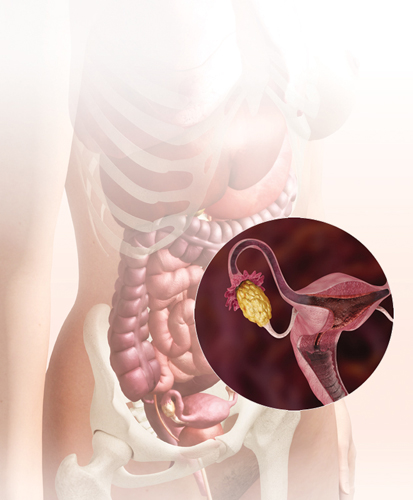
This is Day 1 of your Menstrual Cycle 279 days to go…
This is day one of your
period. If you are trying to conceive during this menstrual cycle, keep a
note of this highly significant date.
What’s happening inside
The lining of the uterus builds up in the first two weeks of the
menstrual cycle to prepare for pregnancy. The yellow and blue areas
seen here are cells and the pink area, secretions. If no pregnancy
occurs, the lining breaks down and menstruation occurs.
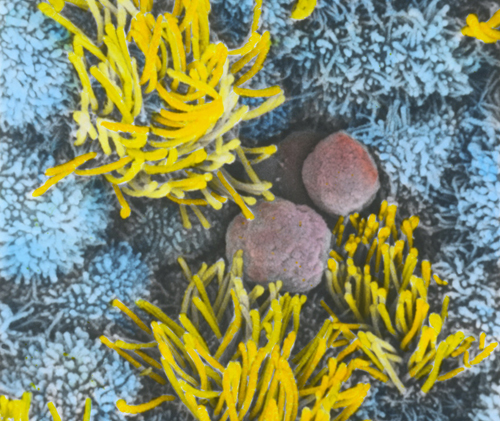
Although this is officially the first day of your pregnancy,
you won’t conceive until around two weeks from now. This is classified
as “day one” because once you conceive your pregnancy will be dated from
the first day of your menstrual period. It would be more logical to
date a pregnancy from the day of ovulation or conception, but, like most
women, you’re unlikely to know the day on which you ovulate, let alone
conceive. You are, however, far more likely to remember when your last
period started, especially if you’re hoping to get pregnant and are
keeping a record of your menstrual cycle.
While dating a pregnancy
in this way is a handy, if slightly baffling, convention, it does mean
that your body is getting geared up for pregnancy from today. In around
280 days, or nine months’ time, you could be holding your newborn baby
in your arms. Good luck and enjoy the journey!
… Nutrition
Take folic acid
Start taking this vital supplement now,
from day one, if you haven’t already. You should take folic acid as
soon as you begin trying to conceive because it will be essential to
your baby’s development in the first few weeks of pregnancy.
The amount of folic
acid that has been shown to be effective is a daily supplement of 400
mcg. A diet of foods rich in folate is also advisable so eat plenty of
green vegetables, such as green beans, spinach, and broccoli; legumes,
such as peas, beans, and chickpeas; fortified cereals; and wheat germ
and other fortified grains.
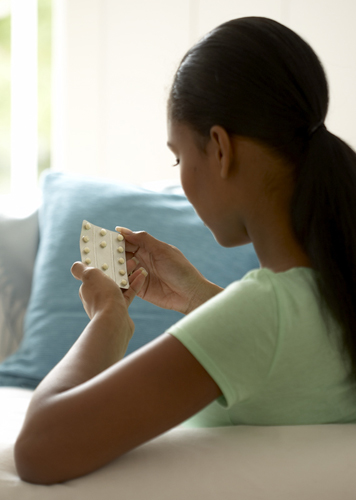
Having a baby
There’s no perfect time to become parents, but you might want to bear in mind the following:
While practical matters
such as the state of your finances and the size of your house are
considerations, remember that being parents is about more than what you
are able to offer your baby materially.
This is a decision only you and your partner can make. Don’t act on the advice of family members and friends.
You might conceive immediately or it could take several months, so relax and don’t have a set date in mind.
Just 20 percent of couples actively trying to conceive become pregnant in the first monthly cycle.
For 75 percent of
couples it takes six months. So be patient and try not to get too
stressed if you don’t manage to conceive immediately.
This is Day 2 of your Menstrual Cycle 278 days to go…
By tracking your menstrual cycle and understanding how it works, you may increase your chances of conceiving.
What’s happening inside
Your eggs are already developing, as can be seen in this
color-enhanced ovary. The small white structures are the immature
follicles that contain the eggs at different stages of development. Once
one of the follicles matures, the egg will burst out.
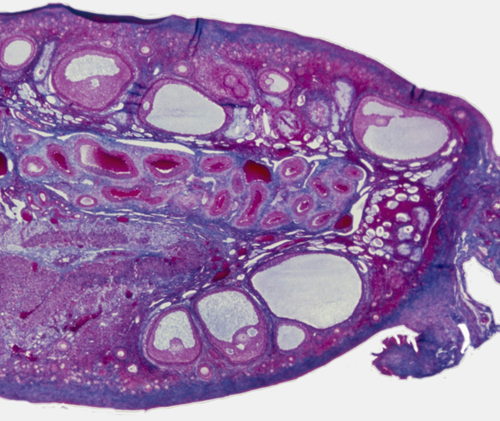
This is day two of your period
and day two of your complete menstrual cycle, which starts on the first
day of your period and ends on the first day of your next period. A
full cycle is, on average, 28 days, but many women have a shorter or
longer cycle.
This may be the time
when your period is at its heaviest, since the tissue and blood that
make up the lining of the uterus (the endometrium) is shed. The average
blood loss during menstruation is around two tablespoons (30 ml). While
the lining is being sloughed off, the blood vessels in the uterus
constrict, which can cause cramplike period pains. As soon as your
period has finished, an egg begins to mature within its follicle in one
of your ovaries, ready to be released around mid-cycle. This is called
ovulation (see This is Day 14 of your Menstrual Cycle).
Meanwhile, the
lining of the uterus starts to build up again under the influence of the
hormones progesterone and estrogen, ready to receive a fertilized egg.
If the egg is not fertilized, hormone levels fall, the lining sheds, and
the cycle begins again.
Changes during the menstrual cycle
The monthly cycle of an egg
as it grows to maturity inside an ovary is shown at the top of the
chart. It is released from its follicle around day 14. The bottom of the
chart shows the corresponding development of the lining of the
uterus—shedding at the start of a period, then rebuilding in preparation
for the fertilized egg.
The empty egg follicle
(called the corpus luteum) secretes progesterone, which is a hormone
that helps the endometrium reach a thickness of about 0.2 in (6 mm) over
the 28 days of the menstrual cycle, ready to receive a fertilized egg.
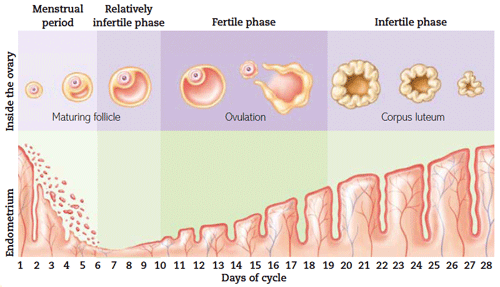
Periods can synchronize in women who live or work together.
Scientists claim that
pheromones (chemicals that trigger a biological response in someone)
waft from one woman to another. Receptors in the nose detect these
pheromones and a biological process takes place whereby one woman
naturally adjusts her menstrual cycle.
This is Day 3 of your Menstrual Cycle 277 days to go…
When you’re trying to get pregnant, it helps to be aware of lifestyle and medical factors that can affect your menstrual cycle.
You may notice the timing and volume
of your period differs. Your menstrual cycle can be affected by stress
as well as by medical conditions, such as an overactive thyroid. In both
these cases, periods can become lighter or less frequent. If your
periods are erratic, it can be difficult to predict when you might
ovulate. Unpredictable or missed periods may mean that ovulation isn’t
occurring at all. If you know this to be the case because you’re
monitoring the signs of ovulation (see Are you ovulating?), or using ovulation predictor tests , seek medical advice about your fertility.
You may be
able to become pregnant naturally and easily despite problems related to
your period, but some conditions that cause long, irregular, or heavy
periods are linked to lower fertility. Heavy periods can be caused by
conditions such as fibroids,
which can affect fertility. A higher than average level of blood loss
can also make you anemic, which is not the best start for pregnancy for
you or your baby, so you may want to look at boosting your iron intake.
Painful periods
can impact fertility. Endometriosis is a common disorder that can make
periods painful and cause discomfort during sex. If you have these
symptoms, see your doctor who might arrange a scan or refer you to a
specialist. In endometriosis, cells resembling those that line the
uterus come to lie outside the uterus on structures such as the ovaries,
the fallopian tubes, and walls of the pelvis. There are treatments for
endometriosis, including laser surgery, that can boost a woman’s chances
of conceiving.
… IVF
Stimulating egg follicles
IVF (in vitro fertilization) may be an option
if a woman is having trouble conceiving. The first stage with this
procedure is to stimulate the ovaries to produce many follicles, so that
multiple eggs can be fertilized outside the body.
Starting on around
day three of your cycle, you will be given drugs to stimulate your
ovaries. You will need to inject yourself (see image)
or use a nasal spray to suppress the normal cycle, followed by
injections of a follicle-stimulating-like hormone. Egg retrieval will
then take place.
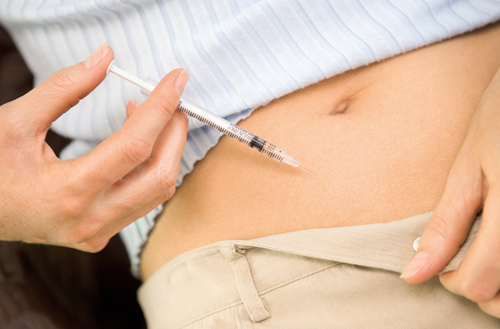
… Doctor
| Q: |
Should I monitor my menstrual cycle?
|
| A: |
Yes, monitoring your cycle is an important part of planning
for pregnancy because it can help you figure out roughly which day
you’re ovulating (see This is Day 14 of your Menstrual Cycle) and thereby improve your chances of conceiving. It means you can ensure you have sexual intercourse at roughly the right time.
It’s also helpful
to note the length of your cycle, which may vary. The most important
thing to note is that from ovulation to the start of your next period is
always around 14 days so when you get your next period, you can figure
out roughly when you ovulated. |